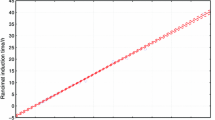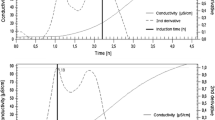Abstract
Oxidative stability is an important parameter in the characterization of fats and oils. The determination of this parameter with the Active Oxygen Method (AOM; AOCS Method Cd 12-57) is both very costly and labor intensive, owing to the repeated peroxide value determinations involved. The alternative rancimat method is based on the conductometric determination of volatile degradation products and features automatic plotting of the conductivity against time. The evaluation is performed graphically after completion of the experiment. The labor required for this method is considerably less as it is not necessary to perform titrations at regular intervals. In the determination of the peroxide values of six samples at three temperatures, ca 151 mixed solvent and chemicals valued at SFr. 400 (ca $180 US) were consumed.
The induction times (t I ) determined with both methods using six different fats and oils show a good correlation (slope 1.005, correlation coefficient 0.987). The rancimat method thus yields results equivalent to the AOCS Method Cd 12–57, but offers a real alternative for the determination of oxidative stabilities owing to the appreciable saving in labor.
Similar content being viewed by others
References
Loury, M., G. Lechartier and M. Forney,Rev. Fr. Corps Gras 12:253 (1965).
Gunstone, F.D.,J. Amer. Oil Chem. Soc. 61:441 (1984).
Frankel, E.N., Ibid.:1908(1984).
Loury, M., and M. Forney,Rev. Fr. Corps Gras 16:167 (1969).
Hadorn, H., and K. Zürcher,Dtsch. Lebensm.-Rudsch. 70:57 (1974).
Frank, J., J.V. Geil and R. Freaso,Food Technol. June:71 (1982).
Loury, M., and G. Lechartier,Rev. Fr. Corps Gras 10:273 (1963).
Official and Tentative Methods of the American Oil Chemists’ Society, Vol. 1, AOCS, Champaign, IL, 1980. Method Cd 8–53.
Pardun, H., and E. Kroll,Fette, Seifen, Anstrichm. 74:366 (1972).
Pongracz, G., Ibid.:269 (1982).
Pongracz, G., Ibid:455 (1984).
Hadorn, H., T. Keme, J. Kleinert, M. Messerli and K. Zürcher,Gordian 300 (1978).
Author information
Authors and Affiliations
About this article
Cite this article
Läubli, M.W., Bruttel, P.A. Determination of the oxidative stability of fats and oils: Comparison between the active oxygen method (AOCS Cd 12-57) and the rancimat method. J Am Oil Chem Soc 63, 792–795 (1986). https://doi.org/10.1007/BF02541966
Received:
Issue Date:
DOI: https://doi.org/10.1007/BF02541966




